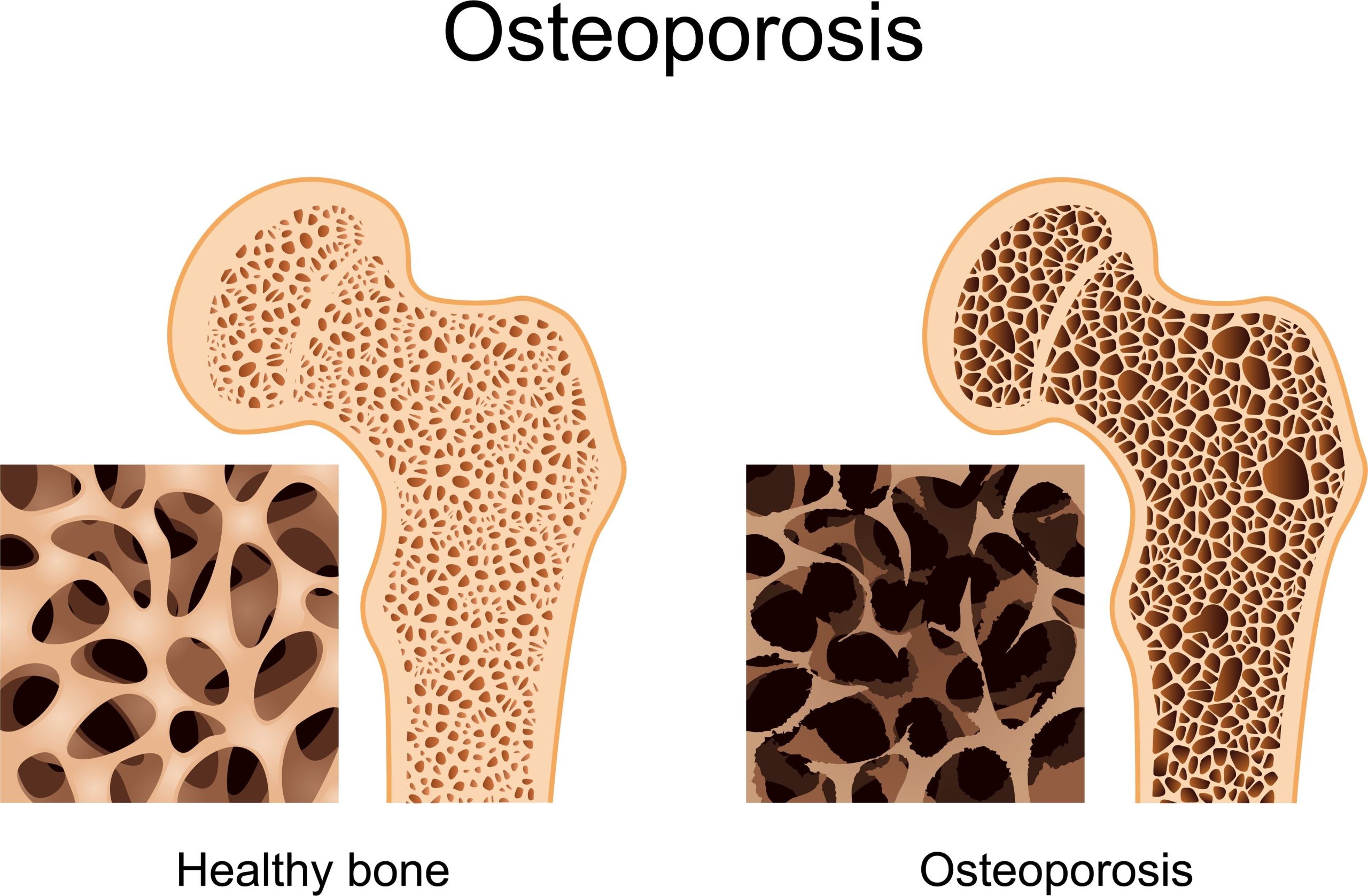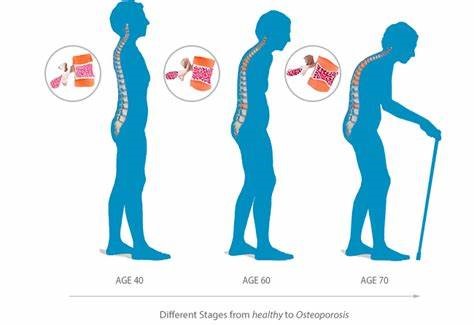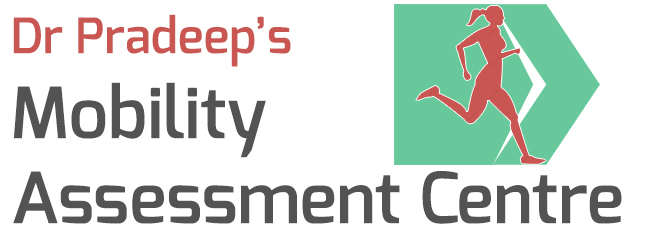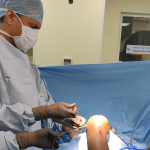Osteoporosis
Osteoporosis (osteos-bone, poros- hollow) causes bones to become hollow and brittle — so brittle that a trivial fall, twist or coughing can cause a fracture. Osteoporosis-related fractures most commonly occur in the hip, wrist or spine. As per health statistics, 1 in 3 women and 1 in 5 men over the age of 50 yrs experience osteoporotic fractures. There is a famous quote by Helen Keller.
” Keep your face to the sun and you will never see the shadows”.
I feel it applies to a great extent in the prevention of osteoporosis. “Keep your body in the sun and you will never see Osteoporosis”
” People who bake in Sun never break their bones”
Bone is a living tissue that is constantly being broken down and replaced. Osteoporosis occurs when the creation of new bone doesn’t keep up with the loss of old bone.


Symptoms
Osteoporosis is known as a Silent Killer as there are no symptoms in the early stage but once your bones have been weakened to a critical level it gives way to an osteoporotic fracture. It can be compared to an Iceberg; we see people with fractures only who form the tip of the iceberg, but a major lot of people who are asymptomatic like the submerged part waiting to come to the top.
Osteoporotic patients might have signs and symptoms that mainly include :
- Back pain, caused by a fractured or collapsed vertebra
- Loss of height over time
- A stooped posture
- A bone that breaks much more easily than expected
When to see a doctor
You might want to talk to your doctor about osteoporosis if you went through early menopause or took corticosteroids for several months at a time, or if either of your parents had hip fractures. Prevention is probably the only way to treat although there are a few medications which may help to a limited extent.
Causes
Human bones are in a constant state of renewal — new bone is made and old bone is broken down. During adolescence, body makes new bone faster than it breaks down old bone and bone mass increases substantially. After the early 20s, this process slows and most people reach their peak bone mass by the age of 30. As people age, bone mass is lost faster than it’s created.
Osteoporosis depends partly on how much bone mass is attained during adolescence. Peak bone mass is partly inherited and varies also by ethnicity. Peak bone mass is like pension scheme – the more you have better is your post retirement life. Similarly more bone you have the less likely you are to develop osteoporosis in old age. Invest in your bones for healthy ageing and living.
Risk factors
It has been scientifically proven that a number of factors can increase the likelihood that one would develop Osteoporosis — including age, race, lifestyle choices, and medical conditions and treatments.
Unchangeable risks
Some risk factors for Osteoporosis are out of your control, including:
- Sex. Women are much more likely to develop osteoporosis than men.
- Age. As one grows old, greater is the risk of osteoporosis.
- Race. Caucasians and Asians are at high risk, African race are less affected.
- Family history. Having a parent or sibling with Osteoporosis puts you at greater risk, especially if your mother or father had fractured a hip.
- Body frame size. Men and women who have small body frames tend to have a higher risk because they might have less bone mass to draw from as they age.
Hormone levels
Osteoporosis is more common in people who have too much or too little of certain hormones in their bodies. Examples include:
- Sex hormones. Lowered sex hormone levels tend to weaken bone. The fall in estrogen levels in women at menopause is one of the strongest risk factors for developing osteoporosis. Treatments for prostate cancer that reduce testosterone levels in men and treatments for breast cancer that reduce estrogen levels in women are likely to accelerate bone loss.
- Thyroid problems. Too much thyroid hormone can cause bone loss. This can occur if your thyroid is overactive or if you take too much thyroid hormone medication
- Other glands. Osteoporosis has also been associated with overactive parathyroid and adrenal glands.
Dietary factors
Osteoporosis is more likely to occur in people who have:
- Low calcium intake. A lifelong lack of calcium plays a role in the development of osteoporosis. Low calcium intake contributes to diminished bone density, early bone loss and an increased risk of fractures.
- Eating disorders. Severely restricting food intake and being underweight weakens bone in both men and women.
- Gastrointestinal surgery. Surgery to reduce the size of your stomach or to remove part of the intestine limits the amount of surface area available to absorb nutrients, including calcium. These surgeries include those to help you lose weight and for other gastrointestinal disorders.
Steroids and other medications
Long-term use of oral or injected corticosteroid medications, such as prednisolone and cortisone, interferes with the bone-rebuilding process. Osteoporosis has also been associated with medications used to combat or prevent:
- Seizures
- Gastric reflux
- Cancer
- Transplant rejection
Medical conditions
.
.
The risk of Osteoporosis is higher in people who have certain medical problems, including:
- Celiac disease
- Inflammatory bowel disease
- Kidney or liver disease
- Cancer
- Multiple myeloma
- Rheumatoid arthritis
Lifestyle disorders
.
.
Some bad habits can increase your risk of Osteoporosis. Examples include:
- Sedentary lifestyle. People who spend a lot of time sitting have a higher risk of osteoporosis than do those who are more active.
- Excessive alcohol consumption. Regular consumption of more than two alcoholic drinks a day increases the risk of osteoporosis.
- Tobacco use. The exact role tobacco plays in osteoporosis isn’t clear, but it has been observed that tobacco use contributes to weak bones.
Complications
Bone fractures, particularly in the spine or hip, are the most serious complications of osteoporosis. Hip fractures often are caused by a trivial fall and can result in severe disability and pain, even an increased risk of death within the first year after the injury.
In some cases, spinal fractures can occur even if you haven’t fallen. The bones that make up your spine (vertebrae) can weaken to the point of collapsing, which can result in back pain, lost height and a hunched forward posture.
Prevention
Good nutrition, regular exercise especially muscle strengthening with weights are essential for keeping your bones healthy throughout your life.
Any weight-bearing exercise and activities that promote balance and good posture are beneficial for your bones, but walking, running, jumping, dancing and weightlifting seem particularly helpful.
Calcium
Men and women between the age of 18 and 50 need 1,000 milligrams of calcium a day. This daily amount increases to 1,200 milligrams when women turn 50 and men turn 70.
Good sources of calcium include:
- Low-fat dairy products
- Dark green leafy vegetables
- Canned salmon or sardines with bones
- Soy products, such as tofu
- Calcium-fortified cereals and orange juice
If you find it difficult to get enough calcium from your diet, consider taking calcium supplements. The Health and Medicine Division of the National Academies of Sciences, Engineering, and Medicine recommends that total calcium intake from supplements and diet combined should be not more than 2,000 milligrams daily for people older than 50.
Vitamin D
Vitamin D improves the body’s ability to absorb calcium and improves bone health in other ways. People can get some of their vitamin D from sunlight, but this might not be a reliable source if you live in a high latitude/ housebound/ regularly use sunscreen/ avoid the sun because of the risk of skin cancer.
Dietary sources of vitamin D include cod liver oil, trout and salmon. Many types of milk and cereal have been fortified with vitamin D.
Most people need at least 600 international units (IU) of vitamin D a day. That recommendation increases to 800 IU a day after age 70.
People without other sources of vitamin D and especially with limited sun exposure might need a supplement. Most multivitamin products contain between 600 and 800 IU of vitamin D. Up to 4,000 IU of vitamin D a day is safe for most people.
Exercise
Exercise can help you build strong bones and slow bone loss. Exercise will benefit your bones no matter when you start, but you’ll gain the most benefits if you start exercising regularly when you’re young and continue to exercise throughout your life.
Combine strength training exercises with weight-bearing and balance exercises. Strength training helps strengthen muscles and bones in your arms and upper spine. Weight-bearing exercises — such as walking, jogging, running, stair climbing, skipping rope, skiing and impact-producing sports — strengthen mainly the bones in your legs, hips and lower spine. Balance exercises can reduce your risk of falling especially as you get older.



